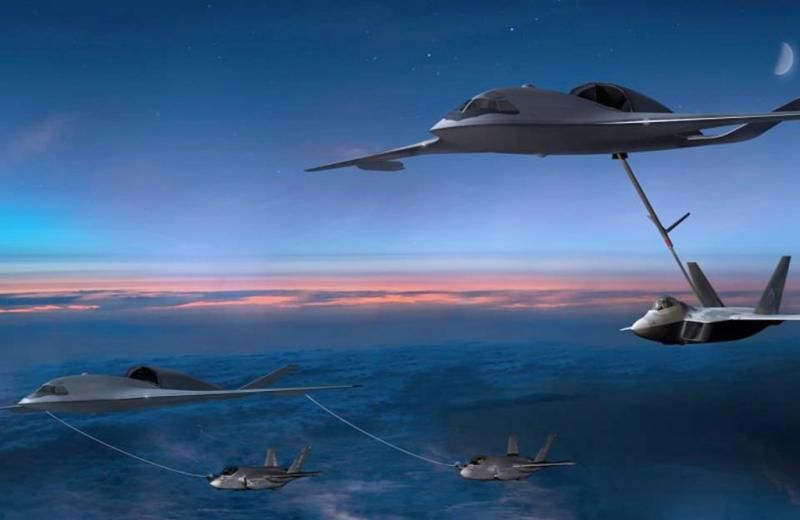AURORA, Colo.—The Air Force is dumping its decade-old strategy of a three-phase tanker recapitalization plan, replacing it with a strategy that will yield about 75 traditional tankers beyond the current run of the KC-46 and then focus on a future, survivable tanker, Air Force acquisition executive Andrew Hunter said March 6.
“We have come to the determination that the kind of KC-X, -Y, -Z strategy that was established in the 2009-2010 timeframe is no longer fit for … meeting the air refueling needs of the joint force in the 2030s and beyond,” Hunter told reporters at the AFA Warfare Symposium.
The new Next Generation Air-refueling System, or NGAS, is “focused on ensuring” that USAF tankers in the mid-2030s and later “will be able to survive and operate in a much more contested environment than the tankers of the past or the tankers that are in our current fleet,” which include the KC-46, Hunter said.
Through analysis done as part of Air Force Secretary Frank Kendall’s operational imperatives, Hunter said there are too many “threats that are posed by potential adversaries to high-value aircraft, including tankers,” and USAF needs an approach that addresses those threats while still meeting its obligations to refuel the joint force “in all of the critical operations that are required for high intensity conflict.”
Hunter said the Air Force consulted with Boeing and Lockheed Martin on when they could deliver new tankers after Boeing finishes its current contract for 179 KC-46s. Boeing could produce an uprated KC-46 by 2032 and Lockheed could provide an “LMXT” tanker, based on the Airbus A330, by 2034. By that time, USAF doesn’t want to be buying traditional tankers anymore, Hunter said.
Buying 75 further “traditional” tankers beyond the 179 KC-46s, USAF can stick to its schedule of retiring the KC-135 and KC-10, Hunter explained. After that, it will pursue a competitive program for a new airplane, but he indicated the KC-46 offers the best opportunity to “dovetail” with current production and not have a break in tanker recapitalization. The Air Force will decide on how to approach the purchase of the 75 aircraft—whether it will be sole source or competitive—in the next few months, he said. Either choice would require negotiations, but a sole source award to Boeing could move the program faster. He noted that if the KC-46 is chosen, it will likely cost more; not only because of new capabilities that will be added, but because USAF got “a very good deal” on the KC-46.
The KC-46 has been a fixed-price contract that Boeing knowingly underbid. So far, the company has taken more than $6 billion in losses on the program, costs that USAF might have had to bear otherwise.
“We do expect,” based on the information provided by Boeing and Lockheed, that “that that may lead us towards KC-46 as the answer … to that ‘five-year KC-135 recapitalization effort,’ is what we’re calling it,” Hunter noted. “But we do need to hear from industry before we make any final determinations.”
The plan for KC-Y had been to buy about 150 more traditional tankers, Hunter said, but the new plan will “accelerate” the purchase of more advanced aircraft for the mission.
Kendall has for the last year cautioned that the Air Force would probably forego a competition for a so-called “bridge tanker,” preferring to save the money and time of a competition and put those resources toward a more advanced aircraft. A second tranche of KC-46s would have new capabilities in communications and possibly control of uncrewed air vehicles, Kendall has said, but Hunter said those extra capabilities will be scaled back in the new scheme.
“We will go on contract for the last of those [179 KC-46s] in FY 2027 and take deliveries of those aircraft in 2029. So we were looking at a gap of … tanker production, under a competitive approach,” Hunter said.
“The last stage of the business case analysis will be giving industry information about our revised path forward and getting their responses about what they can provide and then make a sourcing determination … by the middle of this … calendar year,” he said.
An analysis of alternatives will get underway this year for the NGAS, and Hunter said that process could take 18 months “to a couple of years.” He also said the Air Force is looking toward an “increment one” of NGAS, and that the aircraft might be iterated in several variants, in order to get a stealthy tanker as soon as possible.
The Air Force wants to work with “a wide variety of potential industry partners, in order to inform our efforts and make sure that the capabilities that are being considered in the AOA is the best, the most innovative and effective options that are out there. … We will look at a clean sheet of paper approach not constrained to commercial derivative aircraft,” Hunter said.
The NGAS will have to have “the ability to go deeper into contested airspace … more advanced self-protection-type capabilities, more advanced networking capabilities,” Hunter said.
The Air Force revealed the NGAS name and idea in a Jan. 31 solicitation to industry. In that request for information, it said it seeks a new tanker to be in service circa 2040.
Asked if the NGAS strategy is an attempt to end-run or wait out Congress—some members of which are unhappy with Boeing’s KC-46 performance and want to see more tanker competition—Hunter said “there’s not a way around Congress.” If Capitol Hill “doesn’t like the plan that I’ve just described to you, they will have something to say about it” and this will “have an impact on our plans. I think we’re very aware of that.”
He said the Air Force will “make our best case that this is the right plan, the right path going forward … And we’ll get feedback. We’ll see what comes out in the … draft legislation and will respond accordingly.”

